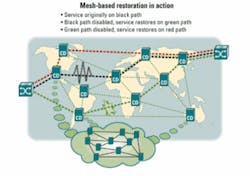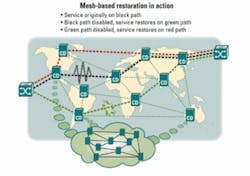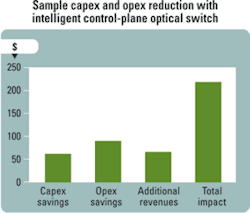by Vinay Rathore
As network operators extend their optical networks globally, they are also driving higher-speed links into smaller end-user sites to enable high-value applications for consumers, businesses, and government organizations alike. Video and voice at home are no less critical to residential customers than business or government services are to their respective end users; network operators understand that a lack of reliability can damage their competitive position as well as potentially cost money for not meeting a service-level agreement (SLA). In particular, while it is commonly recognized that carrier-class service has become a minimum requirement, reliability can be severely tested by potential disruptions that range from a misguided backhoe to a natural disaster.Minimizing the risk and impact of such disruptions requires a fresh approach to building networks that leverages both new technology and industry standards. The approach should include implementation of industry standards-based intelligent control-plane technology, which provides network automation and cost reductions while improving network survivability.
Network globalization has been an ongoing strategic goal for many segments of the market beyond the network operator, including research and education institutions, governments, and enterprises. For instance, government-funded research and education networks rely on their infrastructure for global data interchange during bandwidth-intensive experiments, many of which share supercomputers and cannot tolerate service interruptions. Likewise, large financial organizations brokering transactions in world markets depend on reliable global communications infrastructures that ensure low latency and near 100% uptime, as even a few seconds of network failure can cost millions of dollars.
Moreover, the recent increase in high-profile natural disasters highlights the critical role of a survivable network to the stability, longevity, and�in some cases�survival of global companies. As a result, and given the potential impact�principally economic�of an interruption in transoceanic network traffic, many network operators are moving beyond expensive, pre-existing submarine cable network restoration plans that offer limited protection options.
Meanwhile, consumer demand for broadband services, specifically video and Internet services, and the proliferation of business services within MANs have driven network localization. In addition, local network reliability has become more important as operators expand high-value, revenue-generating business services such as IP-based voice, private-line, and virtual private network (VPN) services. For example, cable operators in North America have positioned network availability and reliability as key features of their rapidly expanding business services portfolios.
So, as consumers make voice-over-IP calls to a neighbor or major Wall Street firms execute billion-dollar online transactions with China, dependence on communication networks grows, as does the need for users to trust their network�s reliability, particularly in the event of a catastrophe. Thus, service providers must evaluate the necessity, complexity, and cost to implement global survivable optical networks�as well as decide how to manage multiple protection mechanisms for each service and integrate them into existing network management infrastructures. As a result, many service providers are turning to control plane-based automation schemes to reduce costs, deliver new services, and enhance network survivability.
In generic terms, a control plane is software embedded at the heart of network equipment that controls every aspect of how that device functions. An intelligent control plane enables a network element to think for itself, given some parameters. More specifically, it is the only practical technology to enable the creation of a fully automated meshed architecture, the single most important ingredient to a survivable optical network.Several devices interconnected with an intelligent control plane can learn from one another and extend automation beyond a single device to the entire network. In fact, large-scale implementations of intelligent control planes extend across the globe in some of the world�s largest networks and have begun to find their way into many smaller networks as well.
Intelligent control-plane technology enables highly simplified point-and-click configuration, activation, and deactivation of circuits. Because the devices are self-aware, they continually manage network inventory, including ports and bandwidth. This self-awareness combined with dynamic inventory management enables operators to manage large, fully meshed networks that are typically too complex to be managed manually. The secondary benefit of this self-aware, automated optical network is its ability to recover from catastrophic failures in as little as 50 msec�the same restoration time as SONET/SDH.
The benefits of intelligent control plane-based networks extend beyond survivability to lower costs and enhanced revenue streams. Because an intelligent optical control plane enables real-time inventory management, it supports the delivery of services on demand. For example, if a new device is added to the network, the ports and bandwidth are automatically discovered and placed into the context of the entire network. Once installed, the new capacity is made available for new services, and any new circuits are automatically added to the pool of circuits that may be used for new services or restoration.
This real-time process automates circuit provisioning, eliminates manual inventory management, enables network survivability, and�as we will see later�can lower operational expenses by nearly 85% and capital expenses by as much as 70%. Key to these cost savings and highly-reliable automation is the control plane software that, based on years of field experience in some of the world�s largest networks, achieves high levels of reliability, resiliency, and efficiency.
The benefits to service providers of network automation are clear. However, industry standards and multivendor interoperability are critical to realizing these advantages on a global scale.
The International Telecommunications Union (ITU) established the Automatically Switched Optical Network (ASON) standard to guide the development of common optical control planes for intelligent optical networks. Those G.ASON requirements and recommendations describe how a suite of control plane protocols should react to service requests by automatically provisioning end-to-end network resources across a multitechnology, multivendor optical network. Such provisioning increases the network�s scope and capabilities without a corresponding increase in manpower.
The next step to extend the intelligence of optical control planes to provision services across a multivendor network is the support of standards defined by the Optical Internetworking Forum (OIF), including the Optical User-to-Network Interface (O-UNI) and the External Network to-Network Interface (E-NNI). O-UNI allows subtended network elements, which also support O-UNI, to request the setup or teardown of light paths across the optical network. Upon receipt of a request from a subtended network element, the Optical Switching and Routing Protocol (OSRP) will perform the operation automatically, which significantly reduces operational costs and enables rapid response to service requests and the generation of new revenues. E-NNI expands the end-to-end automated provisioning capabilities of the intelligent optical network across disparate optical control domains. This interoperability allows rapid service deployment worldwide across multiple carrier networks and varied vendor equipment.
Finally, control plane interoperability using the Internet Engineering Task Force�s Generalized Multi-Protocol Label Switching (GMPLS) Internal Network-to-Network Interface (I-NNI) signaling and routing combines O-UNI and an intelligent control plane to enable automated end-to-end service provisioning within an optical control domain. GMPLS is a standard in progress for common control-plane signaling and routing of LSPs within the optical control domain of a carrier�s network.
One of the key revenue growth opportunities an intelligent control plane offers is its ability to support multiple levels of restoration at the network and circuit levels, an essential element of survivable optical networks. Whether the network is made up of circuits in a MAN, WAN, or undersea cable network, an intelligent control plane enables the creation of multiple restoration schemes down to the individual circuit level, even while overlaid with network-level restoration schemes. The integration of network-level and circuit-level restoration enables 50-msec restoration even in a fully mesh-based network.
An intelligent control plane with mesh restoration also plays a critical role in submarine networks. Undersea cable operators typically control cable restoration schemes that may be expensive and limited to only one other cable system. By leveraging link aggregation (which allows multiple links between two nodes to be managed as a single link) and mesh restoration, an intelligent control plane supports intelligent network scaling, faster restoration times, and network simplification. For customers that require submarine cable diversity without the complexity of managing multiple circuits, link aggregation with mesh restoration is ideal. Capacity is aggregated from multiple cable systems into a bandwidth pool to optimize usage and restoration decisions, lower resource costs, provide greater flexibility, and create the highest level of network survivability.
Typically during a catastrophic failure, a network will automatically begin a sequence of events to restore services while preserving the restoration schemes of the individual circuits (Fig. 1). In the event that a customer demands a specific restoration path for individual circuits, the intelligent control plane would factor this requirement into its restoration plans and restore services accordingly.
For both terrestrial and submarine networks, the flexibility of mesh restoration enables macro-level network protection, granular protection by circuit, and predetermined restoration routes for fastest restoration. Additionally, mesh restoration operates independently of underlying linear and ring protection schemes to offer a multitiered protection hierarchy for each end-to-end connection. Via transoceanic line switched ring (TLSR) protection, undersea connection restoration can be optimized by finding the lowest latency restoration path, which essentially prevents dual ocean crossings to restore circuits. This results in varying levels of restoration that can be sold to customers as a premium service as part of their SLA.
An intelligent control plane�s automation of operating functions�such as service provisioning, equipment inventory, and topology updates�enables service providers to reduce network operations personnel and respond more quickly to requests for new services as well as moves, adds, and changes. In addition, service providers have seen a dramatic decrease in errors as automatic service activation eliminates human intervention and thus human error. Automated service activation can also reduce time-to-revenue and lower service providers� operational expenses for manual provisioning. And the automated process enables a very simple management structure.
So by automating network resource utilization and provisioning as well as managing inventory in real time, intelligent control planes can reduce provisioning and/or service change intervals from months to minutes, which enables service providers to optimize time-to-revenue. In fact, analyses of global networks using intelligent control planes show significant economic benefits based on automation, including up to 70% reduction in capital expenditure and 85% reduction in operations expense while simultaneously improving network reliability (Fig. 2).
The need for survivable networks goes well beyond the typical critical network application and now includes educational entities, governments, and large enterprises such as multinational corporations and large financial institutions. In addition, service providers that wish to sustain and grow high-margin revenue streams, such as those associated with global voice and data services, are increasingly reliant upon their global infrastructure's ability to remain intact duing failures.
An intelligent control plane enhances carrier-class networks to help service providers thrive, scale new service, lower costs and -- most important -- survive single, multiple, or catastrophic failures. As communication networks continue to grow, businesses that implement survivable optical networks will garner higher margins for services, reduce expenditures, and retain the best customers.
Vinay Rathore is director of product marketing at Ciena (www.ciena.com). He has 16 years of experience in service provider networking from Sprint, MCI, Global One, and Alcatel.


